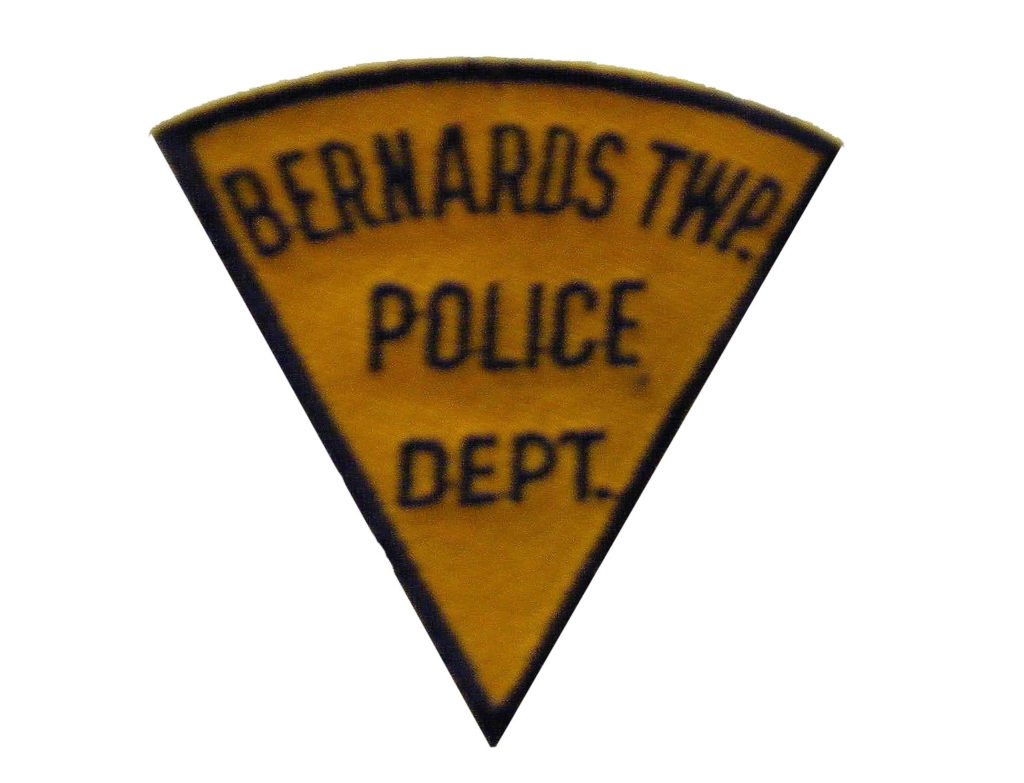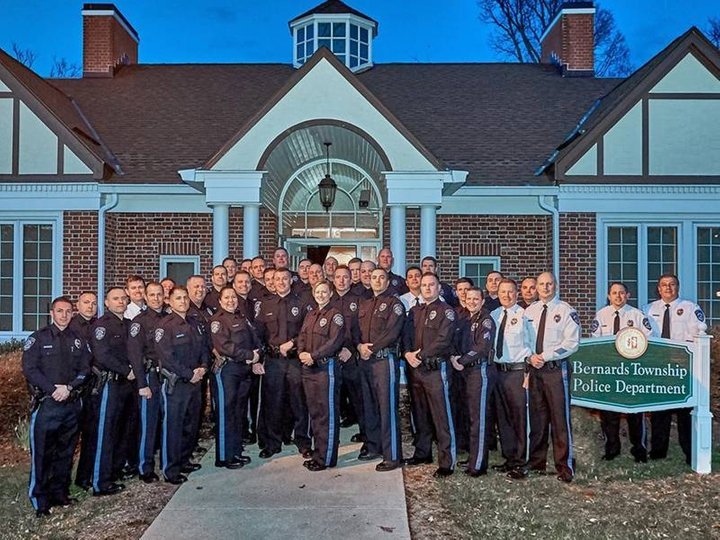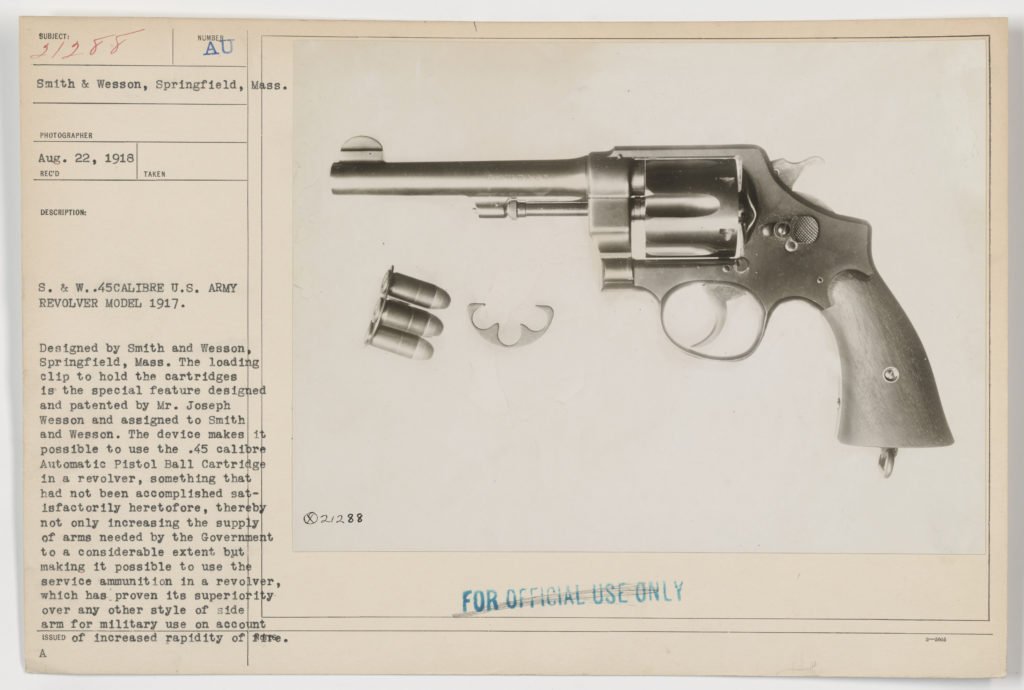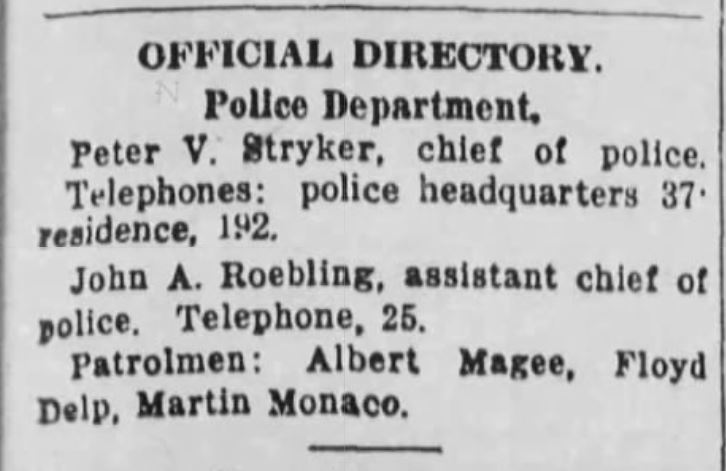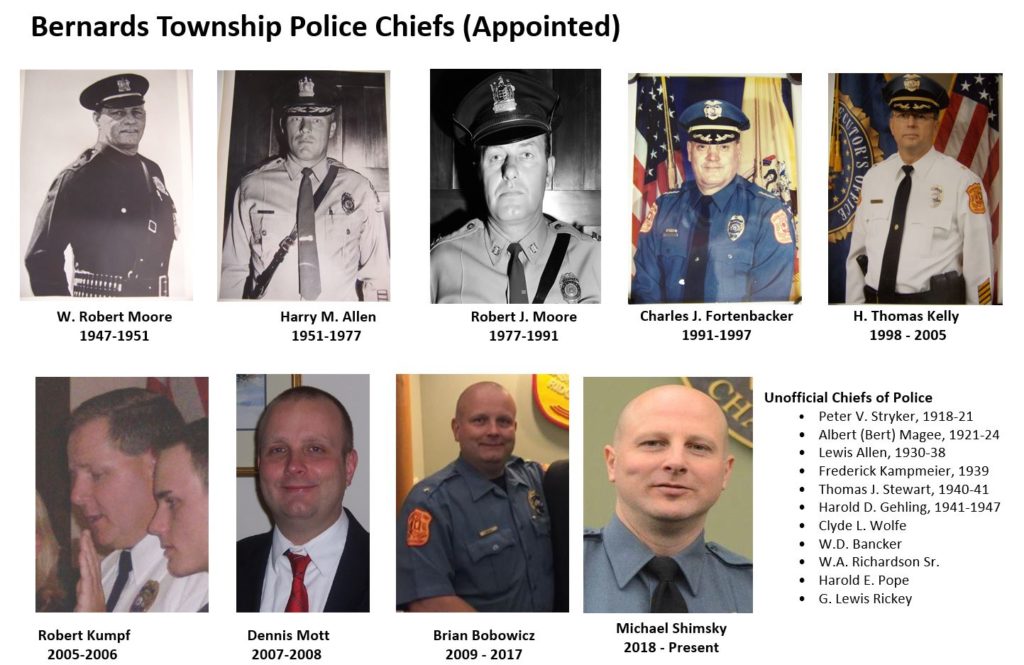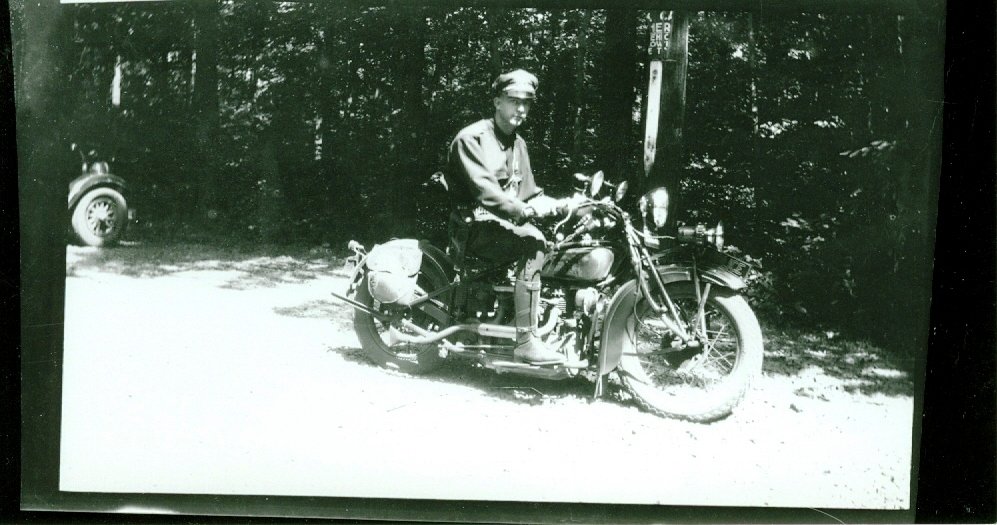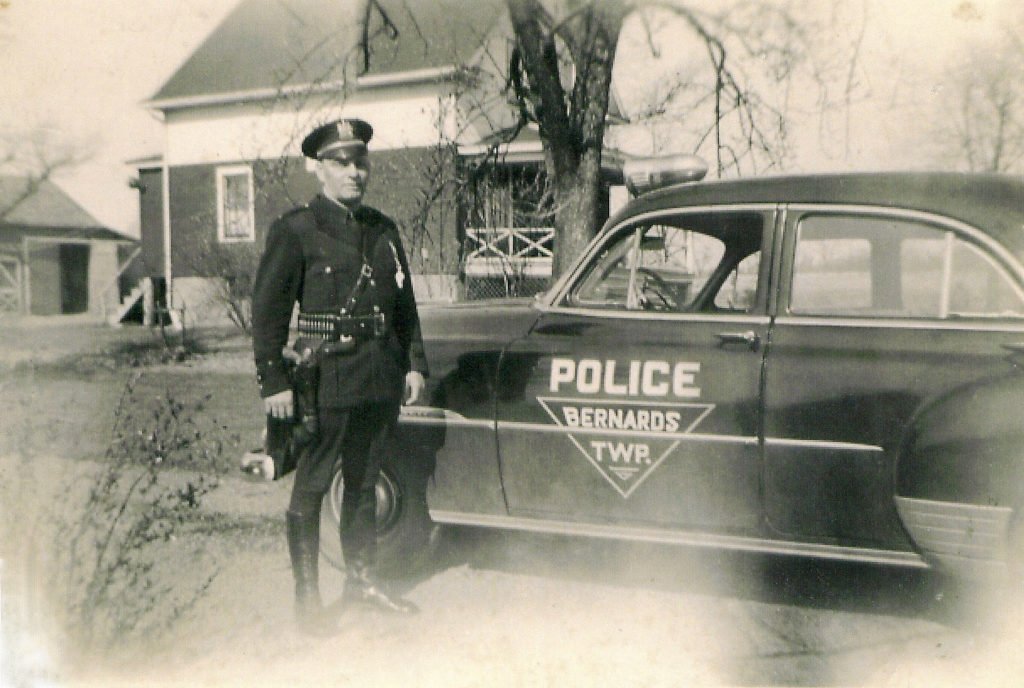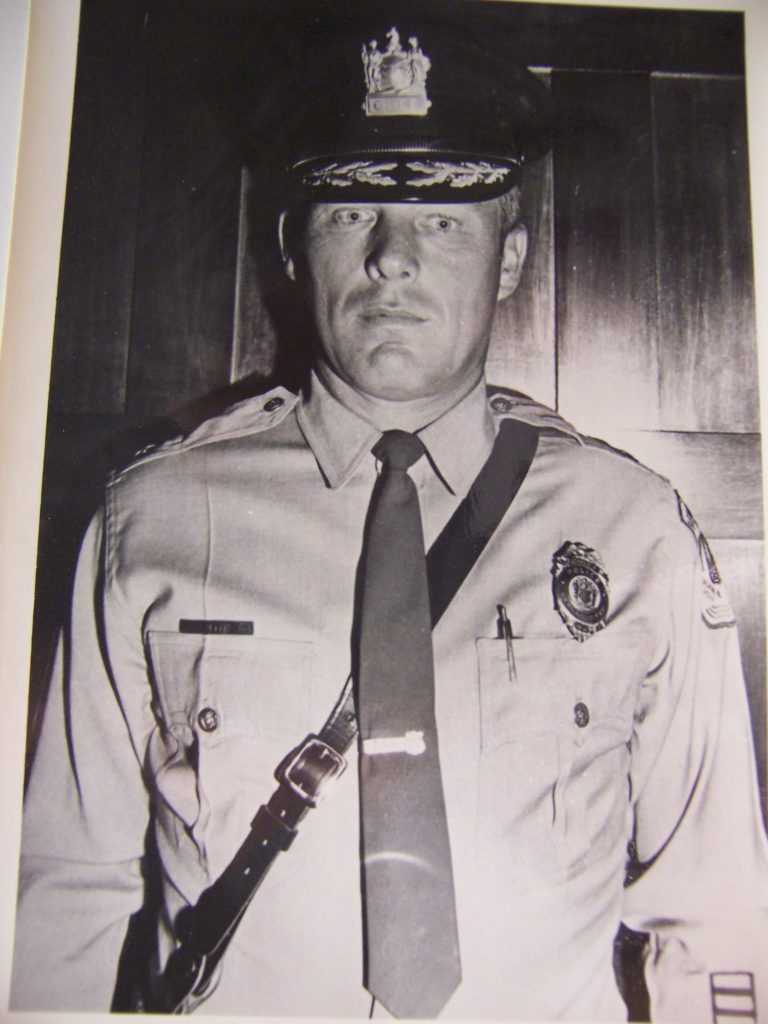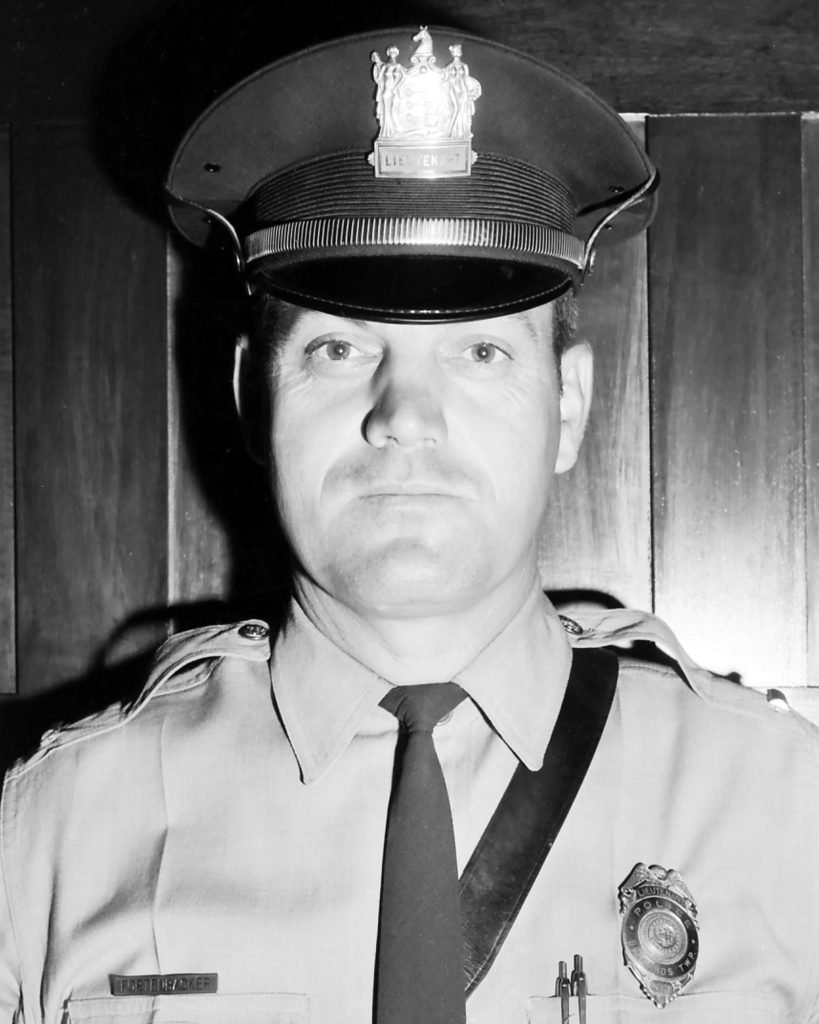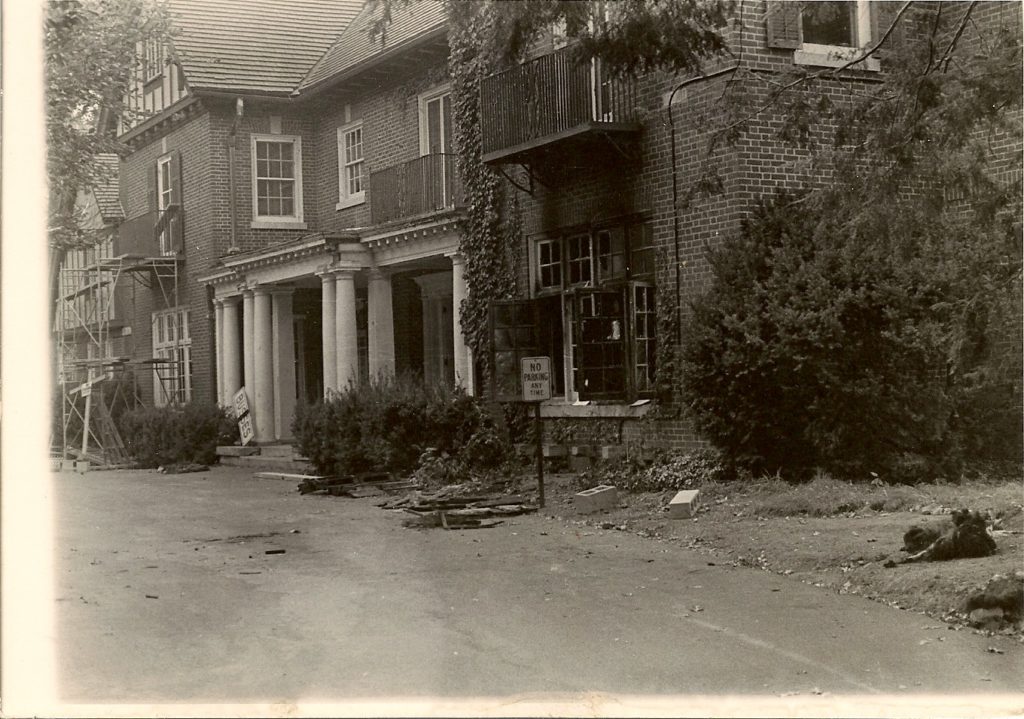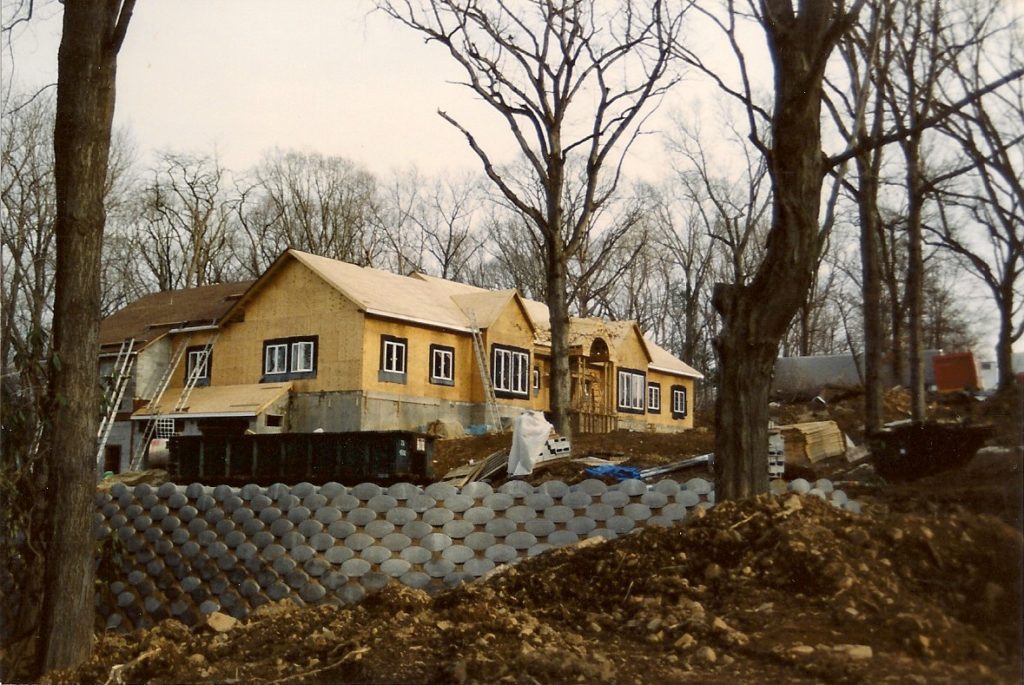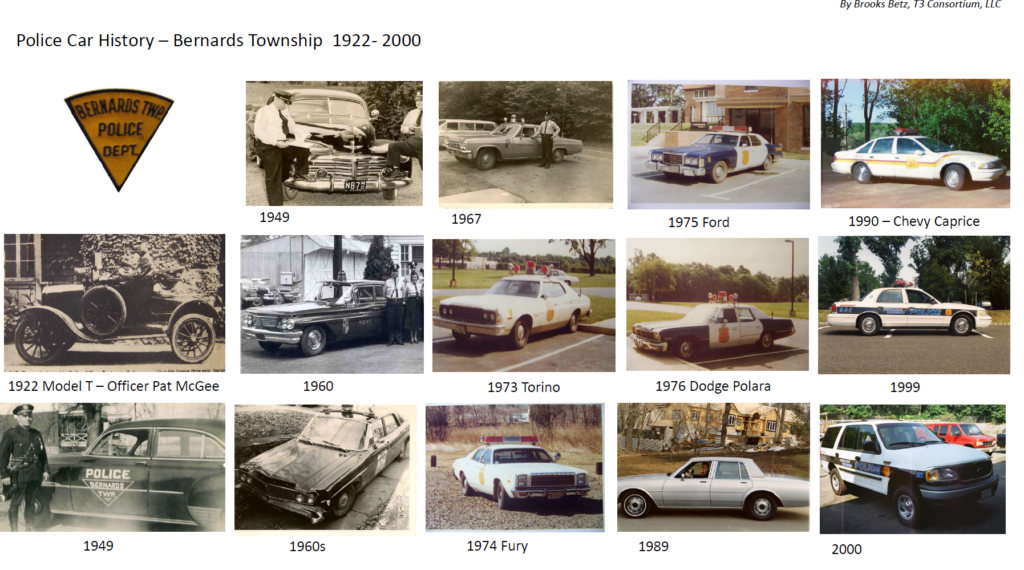2019 – Honoring New Jersey’s Bernards Township Police Department’s 100th Anniversary.
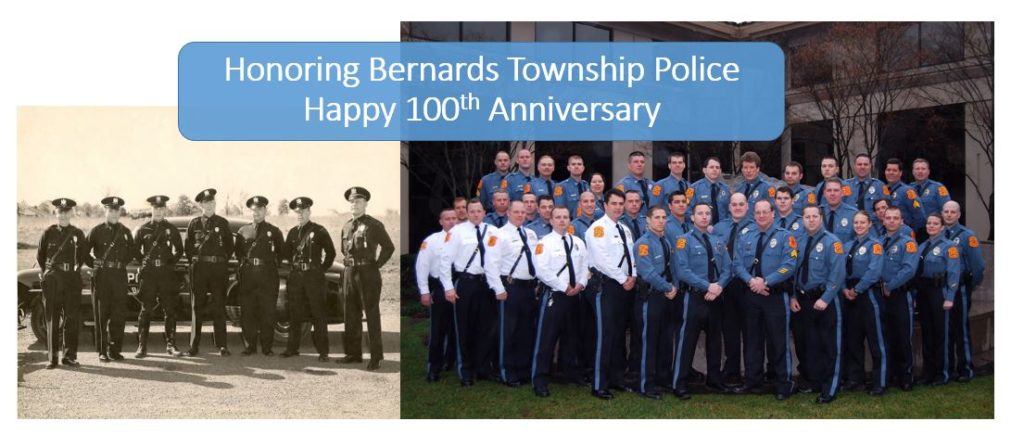
50 Photos in Less Than 6 Minutes
On April 10, 2019, the Bernards Township Police Department will be celebrating 100 years serving the local community. From their beginning as a detective society to the current force they are today, we honor their history. Search social media using #BTpolice100 or tag any stories or images you post with #BTpolice100 and see what comes up.
The following research was compiled initially by June Kennedy, the Bernards Township Volunteer Historian. Mr. Local History picked up the story almost 20 years later and began adding to the details. Below is a collaborative summary of our joint efforts. If you have any details about any of the images or content, we’d love to hear from you. Click Here

Beginnings
About 130 years ago (1868), the bells of the Presbyterian Church in Basking Ridge rang out for more than religious reasons. The “voice” of a citizen’s crime prevention network, the bells tolled for sinners and saints, rousing deputized civilians from their homes in search of suspected perpetrators. The Basking Ridge-Millington Detective Society used the church bells much as the volunteer firemen now use Township sirens to summon volunteers for urgent services.
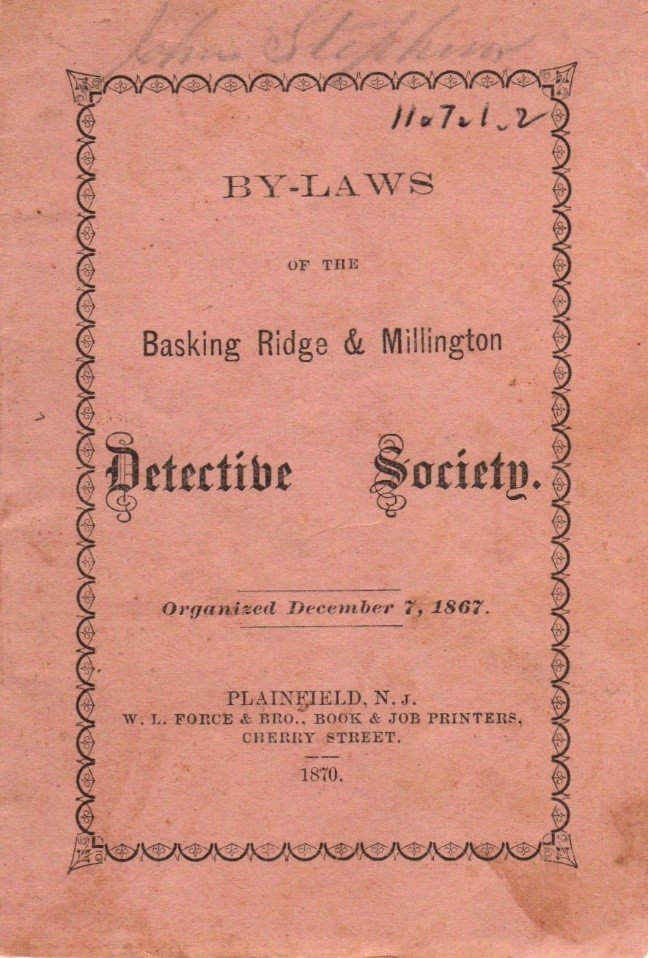
By-Laws of the Basking Ridge & Millington Detective Society, organized December 7, 1867 (3″ x 4 ½”).
Source: THSSH
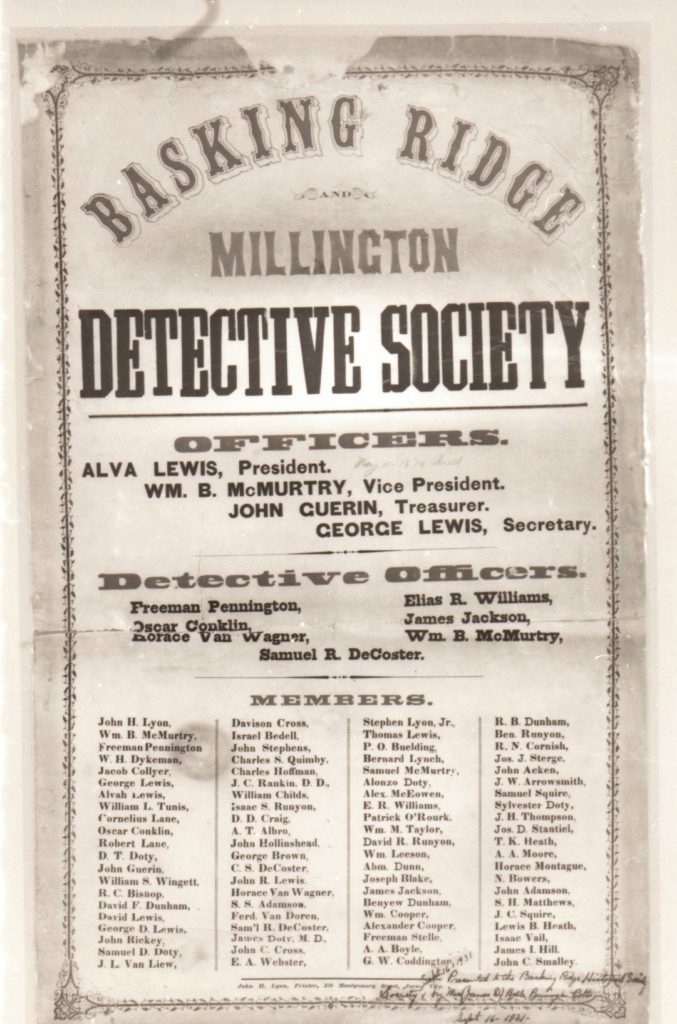
The Society, established in 1867 with 84 members, was the forerunner of the local police department. That, with the Bernards Township Vigilant Society of 1903 and the Bernards Township Protective Association of 1918, is largely forgotten today in local history. Many townspeople did not know there were these groups.
After the Civil War, unemployed people during the Depression of 1869 became hobos and tramps, rode the rails, and also became horse thieves and child snatchers.
The Basking Ridge-Millington Detective Society had its roots in the post-Civil War years, when petty crime was rampant. At the Brick Academy in Basking Ridge, younger children were relocated to the top floor of the building, with the older students on the main floor of School District #12.
None of these “police” were professionals. All had full-time day jobs and would patrol at night. Some commuted into New York after the railÂroad arrived in 1872. Most men were the “upper crust of the community. Very few people were arrested. The “detectives” would hang out, if expecting many people to arrive on the trains, go down to the station and follow them.
These wealthy citizens would arrest Germans, Italians, and Irish, who mostly were domestics, getting into trouble with liquor. Arrests could be for public drunkenness, petty thievery, assault and battery, horse thievery, and house robberies. Constables were hired per arrest, a transition from all civilian volunteers to a professional force.
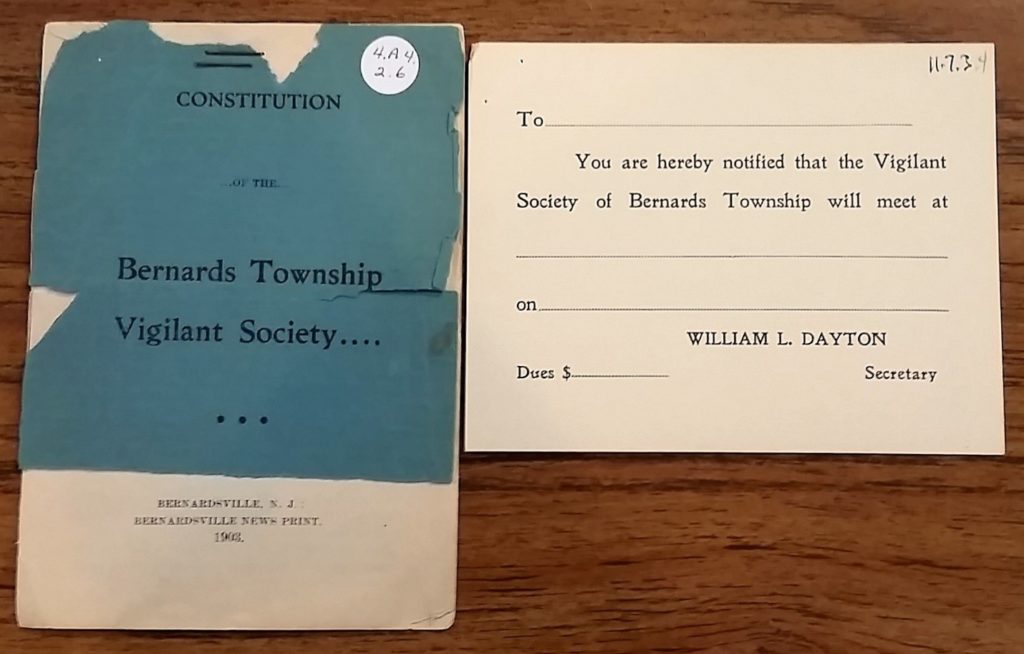
Vintage crime in the early part of the 20th Century included stolen chickens, hay, tires, and beehives; runaway carriages; gamecock betting; stealing furs from traps; escaped veterans; wild and barking dogs; break-ins; gypsy bands; vagrants and suspicious characters—persons warned and placed on good behavior.
Patrolman Gear – 1917
Early 1917 expenses of the fledgling force included: police caps were $2.50 each; badges, $1.20 each; Smith & Wesson guns, .38, $15.90/each; cartridges for Colt pistol, $19.33; flap holsters for a Smith & Wesson, $15.00 a dozen; police winter suits, $30 each, summer suits, $27.50 each; Chester A. Carling earned $80 for patrolling Basking Ridge for a month.
Until 1924, Far Hills and Bernardsville were part of Bernards Township. They separated to form their governments in 1921 and 1924, resÂpectively. Because a large majority of part-time policemen were from BerÂnardsville, Bernards Township relied on a part-time chief and “rent-a-cops” for many years, who were called as needed.
1917 – Township Committee Formally Approves Full-Time Bernards Township Police Department
Bernards Township’s police records were handwritten until 1918. Starting in 1919, typewritten pages appeared in ledgers moving forward. On February 6, 1919, a 17-section set of ordinances was published in the Bernardsville News, stating the formation of the Bernards Township Police Department, which they officially called “The Police Department of the Township of Bernards.”
On Tuesday, April 8, 1919, at the Bernards Township Committee meeting, the Bernards Township Ordinances were adopted, establishing the Bernards Township Police Department. Areas protected were Basking Ridge, Liberty Corner, Far Hills, Lyons, and Bernardsville. Mayor Peter V. Stryker, chairman of the Township Committee, officially was named Police Chief. John A. Roebling of Bernardsville was chosen as Assistant Chief of Police. Note that there still would be a Bernardsville Police Department and the Bernards Protective Association.
It was later reported that even in September 1919, the Bernards Protective Association was still in business, raising over $3,000. $1167 of those funds were given to the Police Department. Many of the force members included those from the famed Bernards Infantry Company, who had seen service in WWI.
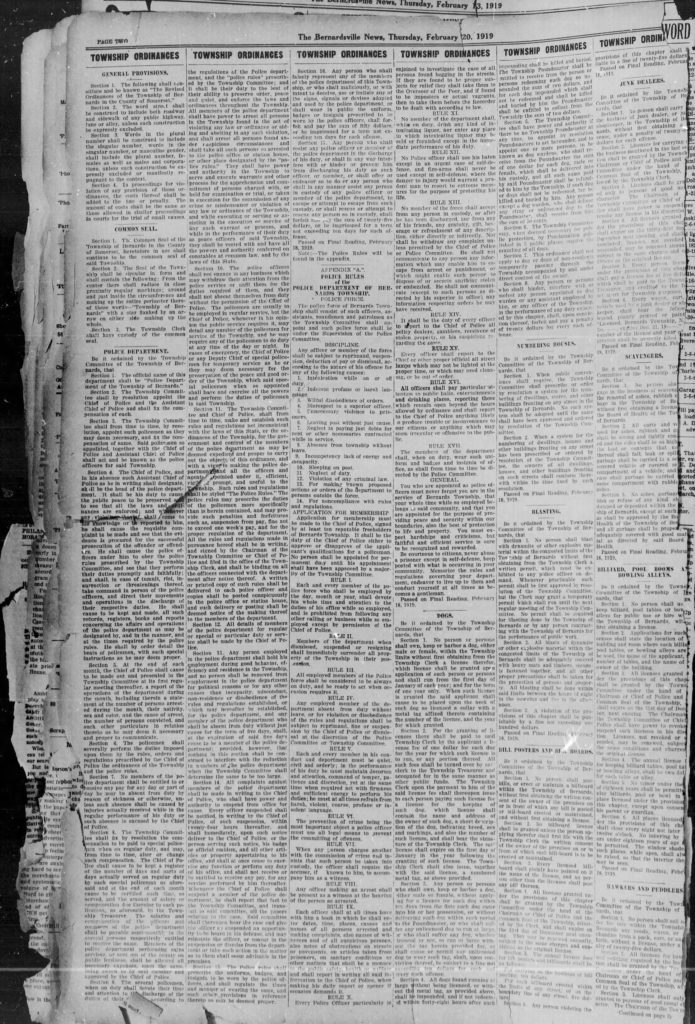
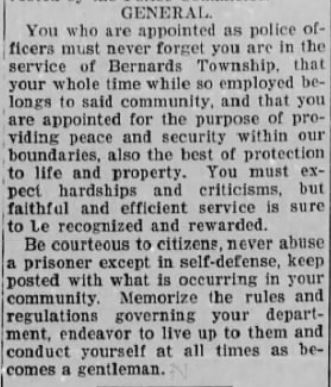
It was also noted that the Assistant Chief of Police, John Roebling, donated the first motorcycle to the Bernards Township Police Department in September 1919. It was a new Indian Motorcycle from De Bows in Bernardsville, who also sold Studebaker Motorcars. Roebling had given a similar Indian Motorcycle to the Bernardsville Police Department the year before.
Bernardsville was Bernards Township Until 1924
With Bernardsville as a new municipality, Bernards Township was without full-time personnel until 1947. From 1924 until 1947, there were special officers and special police chiefs. In the 1920s and 1930s, the Township hired cars for out-of-town trips at $1.00 per hour. Of the earliest police items recorded by Chief Stryker, one was to obtain three motorcycle officers to regulate traffic at a wedding on Forrest F. Dryden’s estate in Bernardsville on June 21, 1919, a request from the Newark Police Department.
Part-time Chief Bert Magee had a Model T. police force patrol car from 1922-25. The only village police force was a constable, usually an old man. Magee, as chief, recorded 106 vagrants (suspicious characters), 66 people were warned and placed on good behavior, and there were 97 public complaints.
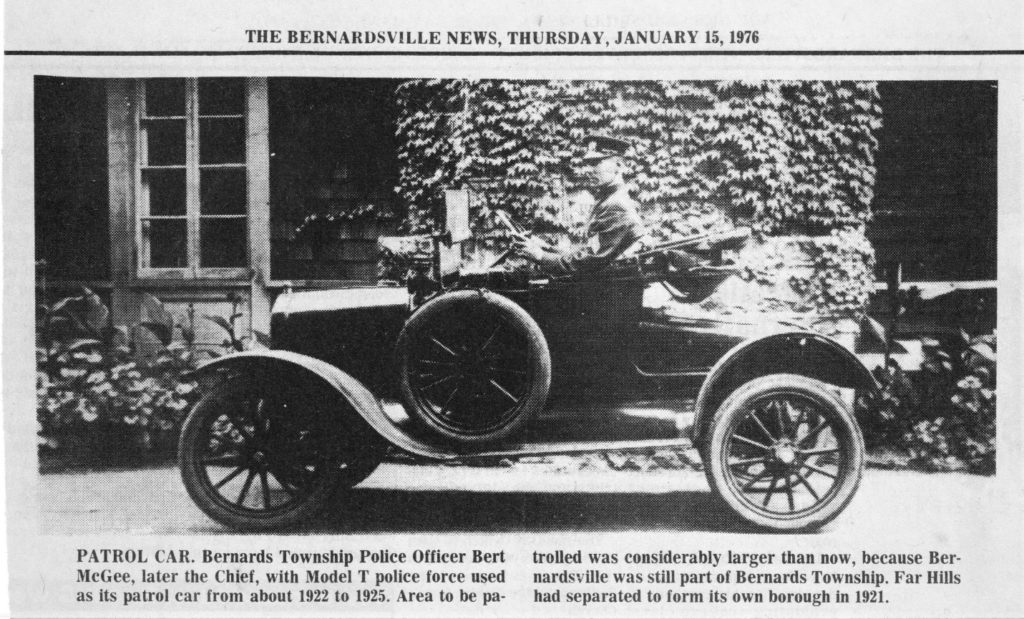
Bernards Township struggled with a full-time chief on a part-time basis. Its equipment included 18 rifles, three 38 revolvers, three sets of handcuffs, five police clubs, 14 police badges, 400 .38 caliber cartridges,1 Chevrolet touring car, and two old motorcycles.
The Municipal Court was located in Bernardsville. The jail was in the basement of the old firehouse on Mill Street, with prisoners for overnight detention at a cost to Bernards of 50 cents each. The BernardsÂville Police Chief was in charge of the jail.
In 1929, Harold Pope, as constable, received 90 cents an hour for patrolling and B.A. Richardson earned $5.00 for patrolling the Township for five hours. By 1933, Louis Allen, supervisor of roads, was chief, receiving $200 a month for both jobs; Clarence Stansbury earned $6.87 for 7 1/2 hours of duty at the Basking Ridge Fire Company’s carnival, and Thomas Stewart got $6.50 for seven hours.
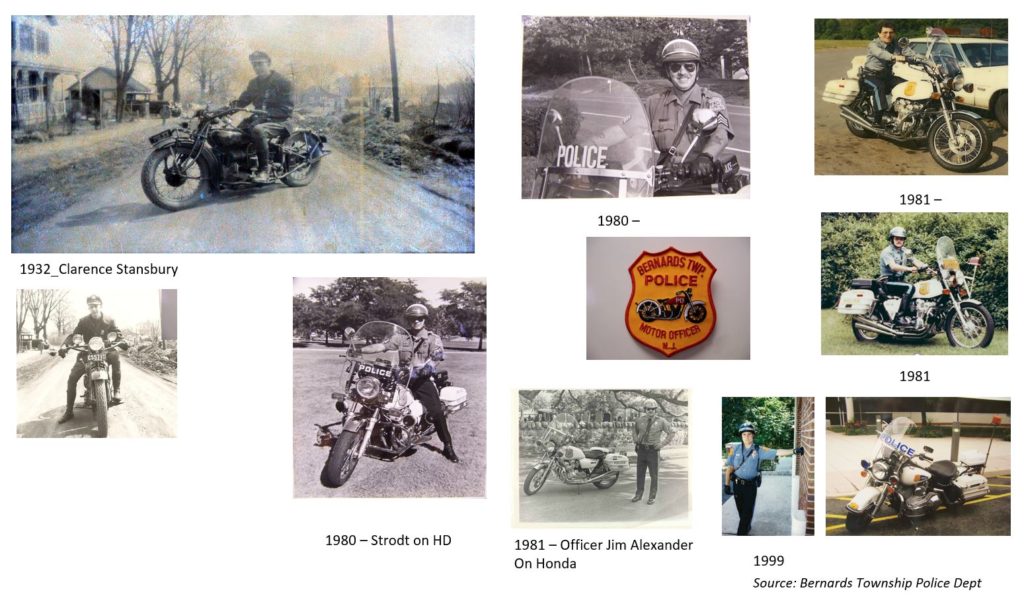
In 1933, supplies needed by the Township Police were purchased at Brown’s Store. These included paper clips, 10₵ cents a box; buck shot, $1.25 a box; 10 batteries for flashlights, $1.00; and lunch for two while on a hold-up case, 70₵ cents. Ralph Bechtold and Charles Fennimore Jr. escorted insane persons to Trenton.
Clyde L. Wolfe, officer for the N.J. Division of Motor Vehicles in its Bernardsville office, served as a police chief and organized parkers for the police department when requested for large parties on the local estates.
On May 4, 1947, W. Robert Moore was appointed a full-time police chief, serving until 1951. Some of the duties during his term included traffic at an air show at the Somerset Hills Airport; shooting a cat having a fit, a missing child found under the child’s bed, riding horses on the railroad tracks, illegal still found; benches in front of the Liberty Corner School placed in trees; an outhouse upset and put on its side; an illegal pinball machine; and runaway pigs uprooting gardens!
On April 20, 1950, Harry M. Allen became Bernards Township’s first full-time patrolman. Robert J. Moore had joined the force in 1948 while his father was chief. Police training was not yet mandatory. There was a three-man department in operation. Moore worked at the North Jersey Quarry under former part-time police chief Thomas J. Stewart. In 1950, Robert Moore was part of the effort to make police training mandatory in New Jersey. He was a member of the fifth graduating class at the N.J. Police Academy in Trenton.
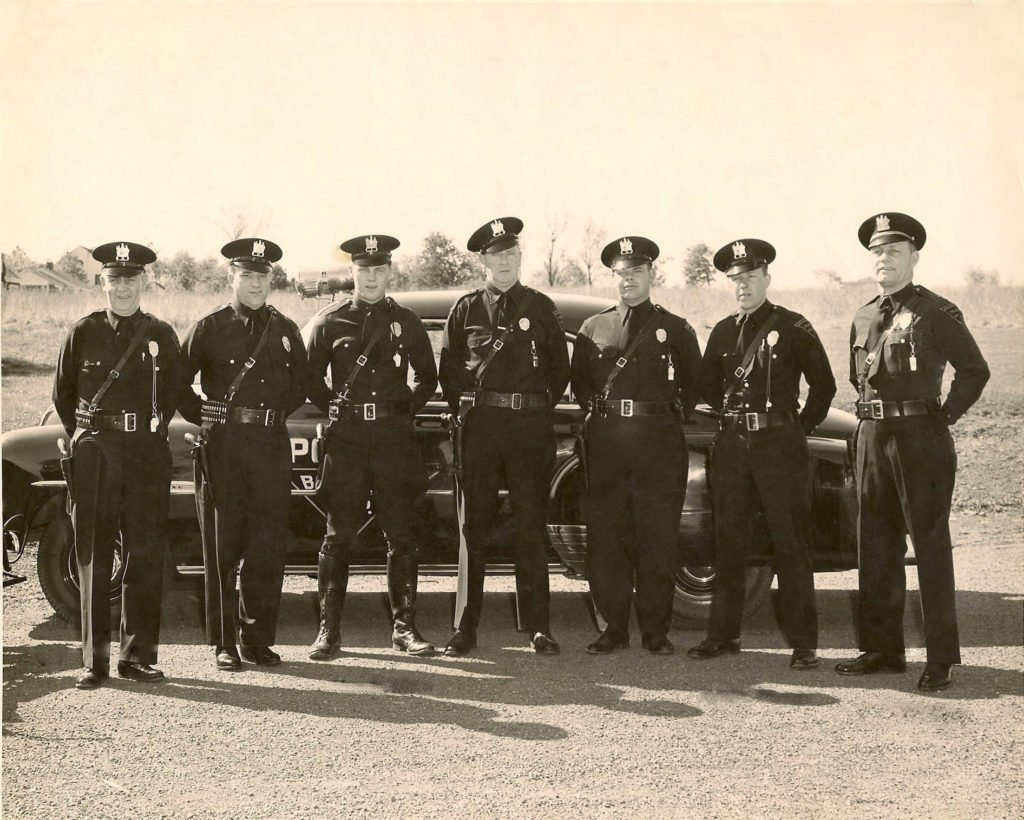
Far Right Robert J. Moore and W. Robert Moore.
Allen was appointed police chief on July 5, 1951, the only person in the department for about 1 1/2 years. Chief Allen, a member of the Bernards Township Police Athletic League, obtained 275 grandstand tickets for the New York Yankees-Philadelphia Athletics baseball game at Yankee Stadium.
Five DeCamp buses transported the avid fans.
In 1955, Charles J. Fortenbacher joined the police department as a special officer, becoming full-time in January 1956. The department was now a three-man department. Robert Moore succeeded Harry M. Allen in 1977 as police chief and served until 1991.
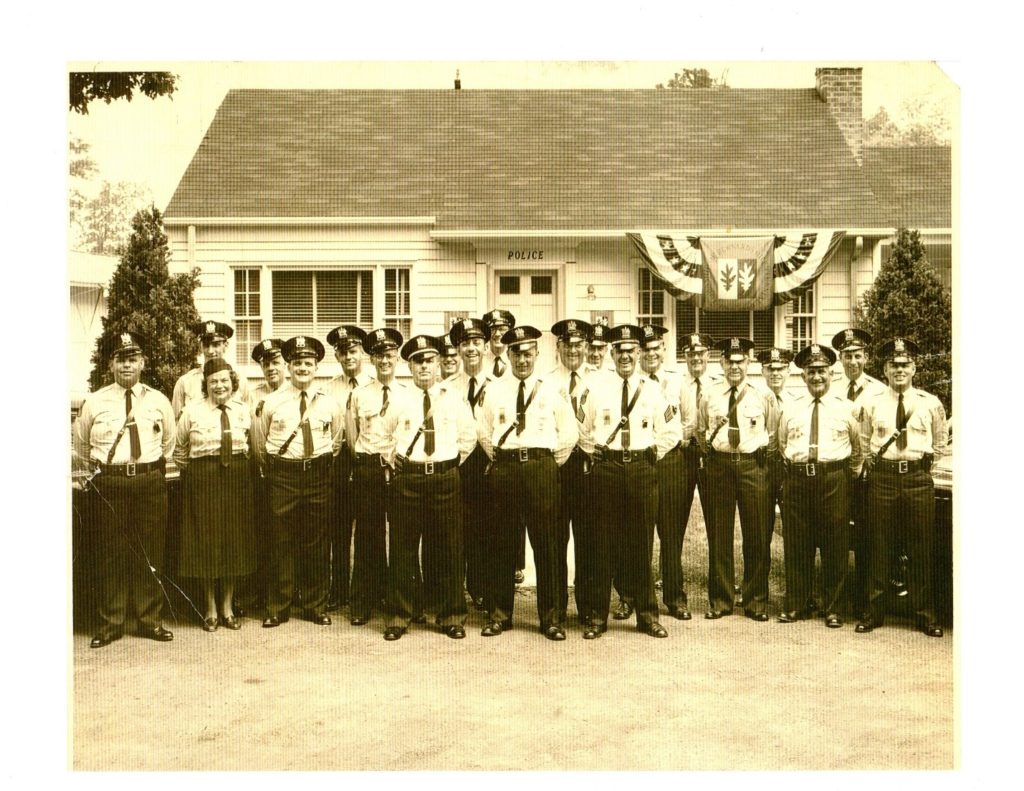
Until the full-time force began to expand in the 1960s, the Bernards police department operated with 20 or more special officers. They filled in on weekends or were backups.
Police Department Locations
In 1948, the police department was located in the basement of the Brick Academy at 15 West Oak Street, which served as Town Hall. When the clerk left each day at 4 P.M., the Town Hall office would shift to an officÂer’s home where his wife would answer the calls. In an emergency, a call would be placed to the Morris County Police Radio System in Morris Plains. Officers did their camera work, dusting and lifting of fingerprints since there were only two people in the Somerset County Prosecutor’s Office.
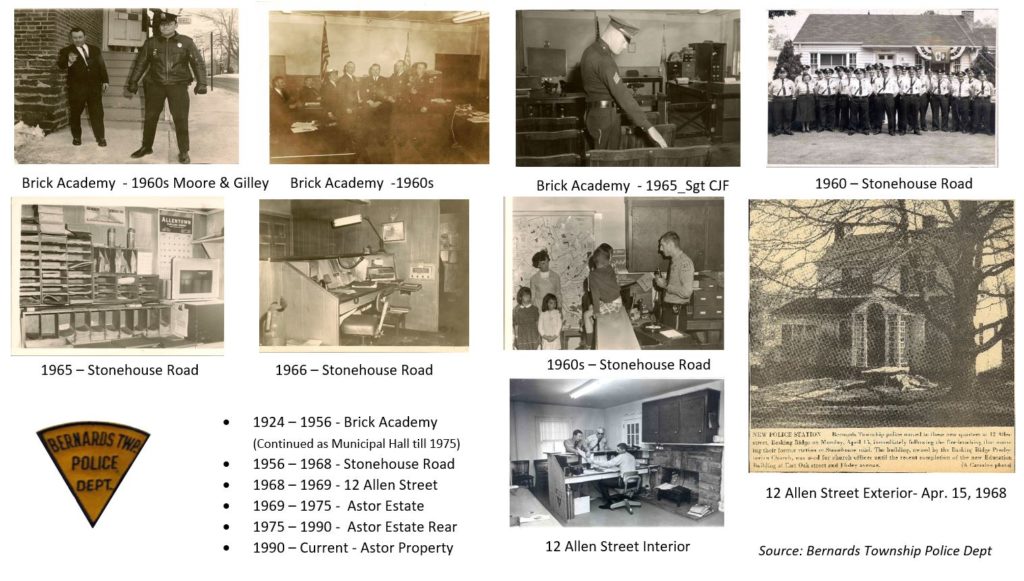
In 1956, the department was moved to the Public Works building on Stone House Road. The structure was firebombed on April 15, 1968. The police were then quartered in a rented house on Allen Street until SeptemÂber 1969 when they were moved to the recently purchased Astor Mansion on Collyer Lane.
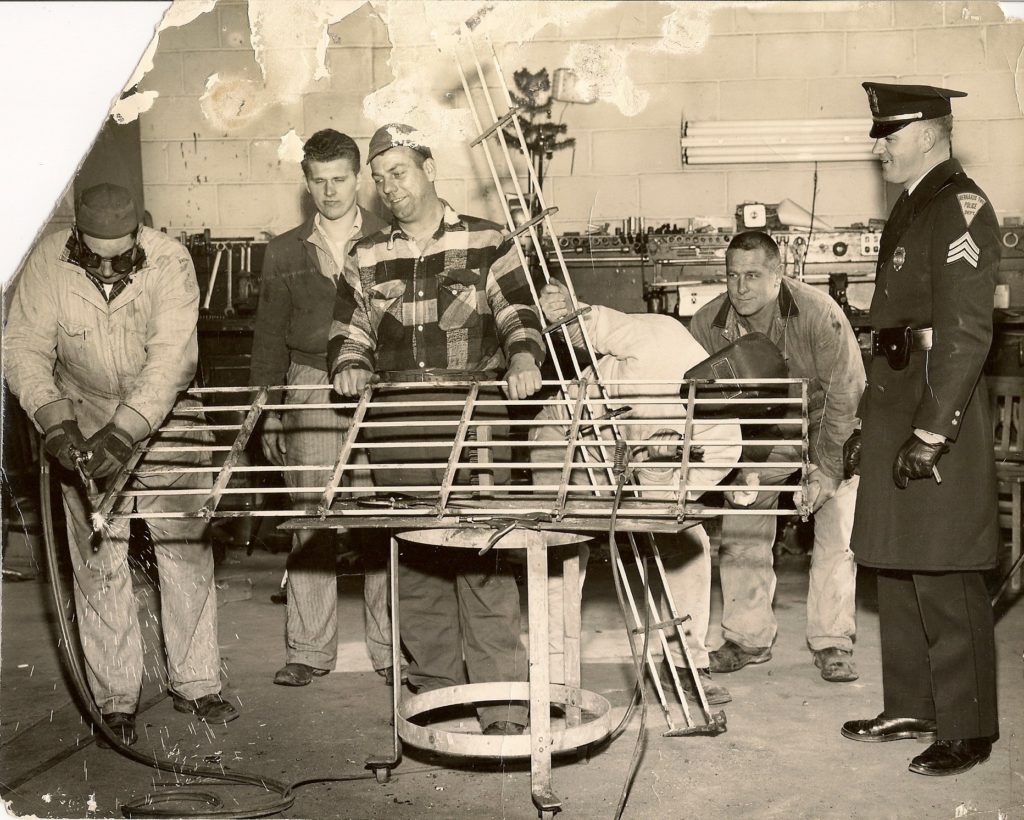
They occupied the reception area, which is now used for administrative offices. In 1975, a $650,000 wing was built onto the rear of the mansion for the police department and courtroom. In 1967, the department switched to around-the-clock dispatching, and four more officers were hired, bringing the staff from 9 to 13.
Mysterious Fire Bombings
The most exciting thing we’ve learned about the Bernards Township Police Department’s history is that there were two firebombings at Stonehouse Station. Then, when the PD moved to the Astor Estate, another firebombing occurred. All three incidents were never solved.
New Digs
By 1969, there were 15 full-time police officers, with a budget of $177,000 for salaries and other expenses. From the department’s new console desk in 1975 came the first call on April 9, a heart attack on North Maple Avenue. (In 1974, personnel included five superiors and 13 full-time patrolmen.)
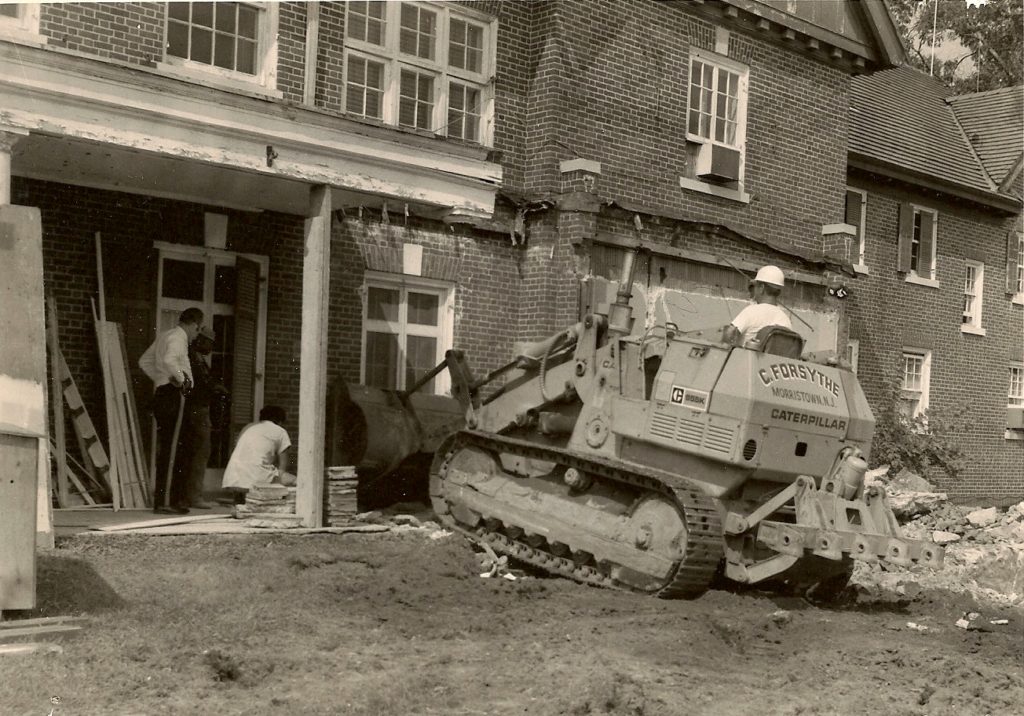
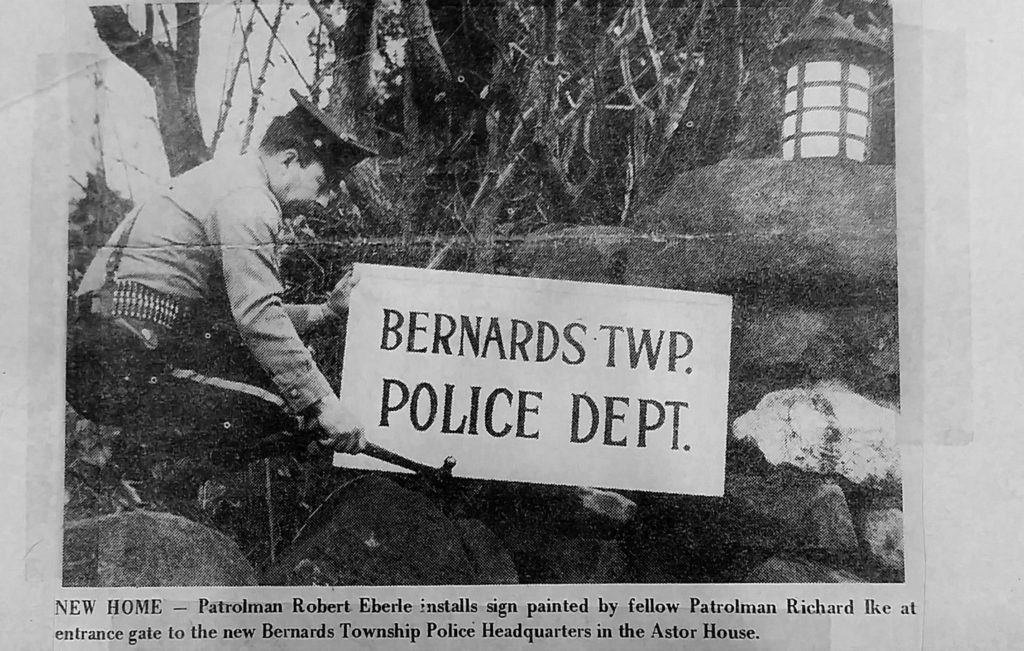
On July 25, 1990, the 12,000-square-foot award-winning Tudor-design Police Headquarters (its present location) was dedicated on Collyer Lane, adjacent to the Town Hall. Construction on this state-of-the-art building began in 1988. Colonel Clinton Pagano, former Superintendent of the N.J. State Police and director of the N.J. Division of Motor Vehicles was the guest speaker at the ceremonies.
On July 1, 1991, Captain Charles J. Fortenbacher assumed the duties of Chief of Police of Bernards Township, a position he held until retirement on December 31, 1997. Captain H. Thomas Kelly was named Police Chief on January 1, 1998.
Bernards Township Police have always been community-involved. Programs include the Neighborhood Crime Watch, Project Graduation, D.A.R.E., and School, in subjects ranging from radar to alcohol awareness education. A Crime Prevention Education, and serving as an instructor at Ridge High School in subjects ranging from radar to alcohol awareness education. A Community Service program, court-administered, began in 1983. The Police Department has highly sophisticated equipment, operates in the 9-1-1 emergency police dispatching system, and uses video cameras. Bernards Township’s Police Department totals 29.
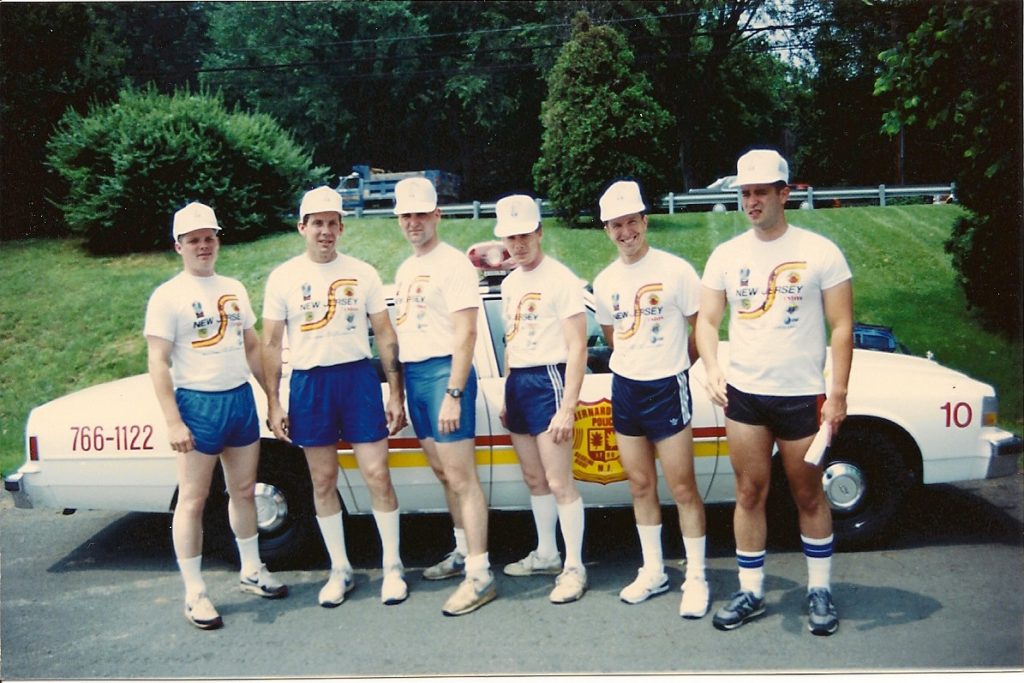
Today’s Bernards Township Police Department
From a population of 3,940 in 1948, Bernards Township residents, three-quarters of a century later (2018), number 27,061—all under the protection of 38 professional law enforcement personnel (2019). We thank and honor our forces for their support and protection over the past 100 years.
Chiefs of Police
- Peter V. Stryker, 1918-21
- Albert (Bert) Magee, 1921-24
- Lewis Allen, 1930-38
- Frederick Kampmeier, 1939
- Thomas J. Stewart, 1940-41
- Harold D. Gehling, 1941-1947
- Clyde L. Wolfe
- W.D. Bancker
- W.A. Richardson Sr.
- Harold E. Pope
- G. Lewis Rickey
Part-Time Constables and Special Officers
- Chester Carling
- Clarence Stansbury
- Edward Amerman
- B.L. Richardson
- Charles Q. French
- Carl E. Mellberg
- George Bolash
- John Wojnar
- Vernon Craig
- Charles Fennimore Jr.
- Ralph Bechtold
- John E. Lee
- Roy Snable
- Joseph A. James
- Howard Huyler
- Charles F. Miller
- Charles C. Turley
- John B. Pope
- Donald Dates
- Edward Pickell
Appointed Police Chiefs (BTPD)
- W. Robert Moore, 1947-1951
- Harry M. Allen, 1951-1977
- Robert J. Moore, 1977-1991
- Charles J. Fortenbacher, 1991-1997
- H. Thomas Kelly, 1998 – 2005
- Robert Kumpf, 2006-2007
- Dennis Mott, 2007- 2008
- Brian Bobowicz, 2009 – 2017
- Michael Shimsky, 2018
Police Locations
- 1924 – 1956 – Brick Academy Municipal Offices/Police Headquarters
- 1956 – 1968 – Stonehouse Road – The department was moved to the Public Works building on Stonehouse Road in 1956. In the early morning of April 15, 1968, the structure was firebombed.
- 1968 – 1969 – 12 Allen Street – Monday, April 15, 1968 – By late the same day, BTPD moves into a rented house on 12 Allen Street until September 1969
- 1969 – 1975 – Astor Estate – Monday, Nov 16, 1969 – The Police Station moved into the Astor Estate property
- 1975 – 1990 – Astor Estate Rear – A $650,000 wing was built onto the mansion’s rear for the police department and courtroom, and the move was made in 1975.
- 1990 – Current – Astor Property – 1 Collyer Lane – On July 25, 1990, the 12,000 square foot award-winning Tudor-design Police Headquarters (its present location) was dedicated on Collyer Lane, adjacent to the Town Hall.
If you have any details about any of the images or content, we’d love to hear from you. Click Here
